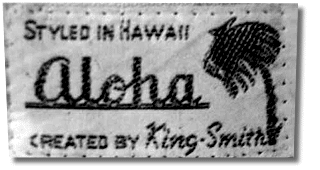Ellery J Chun was born in Honolulu in 1909. He graduated from Punahou School in 1927, then went on to Yale University where he graduated in 1931 with a degree in Economics.
Returning to Honolulu, he was the owner of a Chinatown dry goods shop at 36 North King Street, that he renamed King-Smith Clothiers (the store was named after its location, near the intersection King and Smith Streets.)
With the great depression underway, he looked for ways to increase business; he got the idea to promote a local-style shirt. Using leftover kimono material, he patterned a shirt after the plantation workers’ palaka shirt (short sleeved, un-tucked square bottom.) They had a few dozen made and hung them in the window.
He called them “Aloha Shirts.”
“Since there was no pre-printed Hawaiian fabric around, I took patterned Japanese yukata cloth and had a few dozen short-sleeve, square-bottomed shirts made up for me. I put the shirts in the front window of the store with a sign that said Aloha Shirts.’ They were a novelty item at first, but I could see that they had great potential.” (Chun, 1987 Interview, Star-Bulletin)
They started small, having a few dozen bright printed Hawaiian patterns with hula dancers, palm trees and pineapples. His store became a mecca for a wide range of customers.
In 1936, Chun registered the “Aloha Shirt” trademark.
“It turned out well.”
That year, two firms, Branfleet (the original company was founded in 1936 as a partnership between the Frenchman George Brangier and a Californian, Nat Norfleet; later known as Kahala Sportswear) and the Kamehameha Garment Company, began to shift the focus of the garment industry to a larger and more export-oriented market.
Their products, factory-made sportswear, provided the direction and product line that continues to dominate large segments of the industry today. (Chinen)
A shipping strike in 1936 forced the companies to explore the local island market which brought them renewed success. The years 1936-1939 were big growth years for the garment industry in general and each company typically came out with 15 or more new shirt designs each year.
Paradise of the Pacific published its first photograph of a man wearing an aloha shirt in 1938. Soon thereafter, movie stars took up the fad. By 1940, officials of the Territorial and City and County governments were allowing their employees to wear aloha shirts, at least in warm weather. (Schmitt)
After World War II, a gradual change in aloha wear took place with the breakdown of rigid dress requirements for business attire. The business tie and jacket certainly were not comfortable in Hawaiʻi’s summer climate. In 1946, the Honolulu Chamber of commerce appropriated $1,000 to study aloha shirts and prepare suitable designs for clothing businessmen could wear. (Art of the Aloha Shirt)
In 1947, the Hawaiʻi Chamber of Commerce organized an annual event called Aloha Week, during which office workers were encouraged to shed their suits and wear Alohas to work. In the 1960s, the chamber invented Aloha Fridays, which led to casual Fridays. (Washington Post)
By 1950, however, “screen printing” had emerged, led by companies like Alfred Shaheen and Von Hamm Textiles. This procedure permitted the printing of smaller yardages, expressly for local designers. More important, it permitted brighter and more shaded prints which, from 1947 on, received greater national and international exposure through yearly Aloha Week publicity events. (Chinen)
Up to the middle to late-1950s was considered the Golden Age of aloha shirts. Rayon with smooth finish and Hawaiian prints became the pinnacle of aloha shirts. Complicated eye popping patterns containing all aspects of Hawaiian culture and artifacts were included on the aloha shirts, often referred to as “chop suey” prints because of the mixture of content in the design. (Art of the Aloha Shirt)
The modern era of aloha shirts is considered the 1960s and beyond. In 1962 the Hawaiian Fashion guild staged “Operation Liberation”, giving two aloha shirts to each man in the State House and Senate. The Senate passed a resolution urging the regular wearing of aloha attire from Lei Day, May 1st, and throughout the summer months.
Aloha Friday officially began in 1966, and by the end of the 1960s, the wearing of aloha shirts for business dress any day of the week was accepted. (Art of the Aloha Shirt)
According to Alfred Shaheen, “It (Aloha dress) was really provincial in Hawaiʻi then; the old timers were into formality. They weren’t far from missionaries; in fact, many were descendants of the missionaries so they were still pretty strict and puritanical about things. … So it was a new breed, the younger guys who were ready for a new style.” (Art of the Aloha Shirt)
With aloha dress accepted as every-day wear, Reyn Spooner shirts came on the scene in the early-1960s. Reyn McCullough liked Pat Dorian’s original “reverse” print shirt and started to market it in his Ala Moana Center store. It was a more conservative, “traditional” pullover reverse shirt with a button-down-collar and tails to tuck into slacks. (Tim McCullough)
“Aloha attire is a pan-ethnic expression. What it does is show varied influences coming to Hawai’i. Clothing shows us that all the ethnicities have an impact on what we wear.” (Arthur, UH)
Ellery Chun eventually closed his store and became a bank vice president. He died in 2000; that year, Governor Ben Cayetano proclaimed “The Year of the Aloha Shirt.” (Lots of information here from Aloha Shirts of Hawaiʻi, The Art of the Aloha Shirt and Chinen.)
Chun’s legacy lives on.









